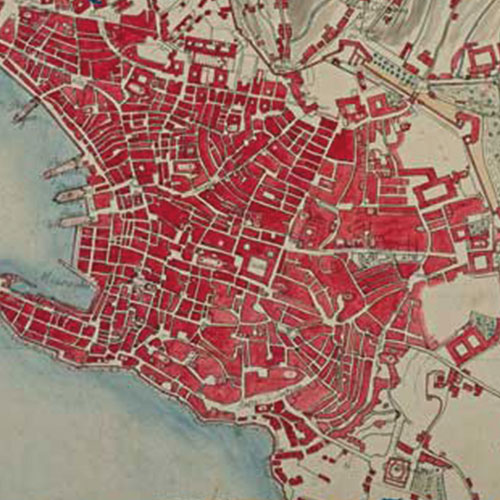Our history
A 300-year journey
From 1699 to the present day
BETWEEN CHANGINGS AND REBIRTHS
MOG’s history tells about three centuries of transformations.
If we wanted to give a brief summary, we would probably say that it must have been thecloister of the convent next to the Church of N.S. della Consolazione, but it became something different, as it can be noticed by entering the Eastern Market.
But, if you want to know more, jeep reading: we will tell you everything.

square meters
seats
kg of iron
stained glazed windows
A journey throughout time
step by step, from 1600 to the present day
Origins
An Augustinian cloister that ends up being something else.
Until the end of the 19th century
An embryonal market as the centre of Genoa blossoms.
The market
1899: an inauguration so spectacular that goes down in history.
Here we are
After a long renovation, from 2019 the market has its navel.
Origins
1699: The first stone for the construction of the Church of N.S. della Consolazione
The first protagonists of this story are the Augustinian fathers and their monastery on the left bank of the Bisagno. In 1656 the monastery became a lazzaretto in order to contrast the outbreak of plague that hit the city. Only after 25 years it was destroyed and the monks were forced to move to the S. Vincenzo neighbourhood, in front of the convent of Santa Maria della Pace, between the old and the new walls, completed in 1637.
It is in that spot, between Porta di Santo Stefand and Porta d’Arco, that the monk started building the church of N.S. Consolazione (consolabitur omnes ruinas) and its convent. To be precise, the first stone was laid on the ground in 1699. The story here takes a decisive turn: the construction of the cloister was abandoned, while the numerous columns of the colonnade of the bottom floor were walled up,leaving space for little shops and little shelters for goods.
The upper floors became apartments for the population, while the Augustinian occupied the third floor. The internal area remained unused and it became a garden. The Market is beginning to take shape.
In this map of Genoa at the end of the 18th century the original location of the convent of Consolazione can be seen.
Until the end of the 19th century
The lower floors was occupied by shops and warehouses, as the centre of the city is blossoming.
Take a look at Alfred Guesdon’s paintings, who often found inspiration for his paintings here in Genoa, made with the litographer Johan K. Schulz.
The Acquasola gardens, still united with Villetta di Negro, stretch out behind the city, sloping down to the sea. In the corner of the foreground the back side of the Church of Consolazione with a part of the convent can be seen as it was in the mid-19th century.
In the mid 19th century, the area was enriched with a new neighbourhood between Via S. Vincenzo and the Church of Consolazione, along the tracks of Via Galata and Piazza Colombo. To the south stands the bulk of the Abrara Asylum, a round building with a radial structure, built between 1834 and 1841 to a design by Carlo Barabino and then destroyed in 1912, making way for the new streets, now known as “del quadrilatero”.
Alfred Guesdon (painter) Nantes 1808-1876 Johan K. Schulz (litographer)
Gdansk 1801-1873 Genoa from above to the west.
Particular litography, 1849 Genoa, DocSAI Centre,
Topographic Collection of Municipality of Genoa
The market
1899: Inauguration of the Eastern Market
The market space was a scene of demonstrations and events for 20 days: there was a lot of talk in the newspapers about the launch of 500 carrier pigeons, promoted by Fert society. The municipality understood the touristic potential of the event, therefore it provided a tram service, from Brignole, Raibetta square and Corvetto square.
Reading the edition of Genova Nuova, which reviews all ‘the new and beautiful things with which Genoa was enriched’ in the second half of the century, we find a chapter devoted to the New Eastern Market:
“The work has turned out to be a real jewel, both in its details as well as in its sober and elegant architectural line and also in its eminently decorative overall”.

Celestino Foppiani (drawer) Nicolò Armanino (engraver)
Genoa’s map. Particular litography, 1853 DocSAI Centre, Tipographic Collection of the Municipality of Genoa
Here we are
The inauguration of our spaces in 2019
Our MOG, opened on the 7th of May 2019, is the last step of this evolution:it is the navel of the Eastern Market, its natural prosecution, a place set in its own time that knows its incredible history well and makes the territorial and socio-cultural entrenchment a value to be proud of.











